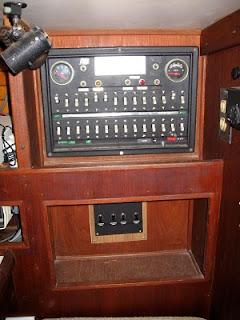 Nan and I returned home from our Central America sailing trip on Saturday, May 8. The following Monday, just two days later, I flew to Baltimore to take a second look at Little Walk. John Kretschmer flew up from Fort Lauderdale to meet me and take a look for himself. The two of us met Ray, the owner, and Bob, the broker, at the boat, which was docked at Ray's friend Tony's pier on Rock Creek, near Riviera Beach, southeast of Baltimore. John and I spent about an hour looking at the boat, inside and out, using copies of the marine survey as our guide. I took advantage of Ray's intimate knowledge of the boat and asked dozens of questions, which he answered patiently and proudly, providing me with an invaluable orientation on the boat's many systems. John checked the chainplates, mast and bilges, looked into every nook and cranny, and then started a conversation with Bob in the cockpit, while I continued the orientation with Ray and took photos until the camera batteries died.
Nan and I returned home from our Central America sailing trip on Saturday, May 8. The following Monday, just two days later, I flew to Baltimore to take a second look at Little Walk. John Kretschmer flew up from Fort Lauderdale to meet me and take a look for himself. The two of us met Ray, the owner, and Bob, the broker, at the boat, which was docked at Ray's friend Tony's pier on Rock Creek, near Riviera Beach, southeast of Baltimore. John and I spent about an hour looking at the boat, inside and out, using copies of the marine survey as our guide. I took advantage of Ray's intimate knowledge of the boat and asked dozens of questions, which he answered patiently and proudly, providing me with an invaluable orientation on the boat's many systems. John checked the chainplates, mast and bilges, looked into every nook and cranny, and then started a conversation with Bob in the cockpit, while I continued the orientation with Ray and took photos until the camera batteries died. The weather was threatening rain, but we all agreed that we should take the boat out for a quick sea trial. Ray showed me how to power up the diesel engine and turn on the water coolant seacock. We let the engine idle for a few minutes to hear how it sounded before casting off the lines and motoring up the creek to Chesapeake Bay. Once we had reached open water, Ray revved the engine's RPMs up to cruising speed and insisted that I take the wheel. The boat steered smoothly and responsively, and the engine sounded smooth and steady. We put up the mainsail and unfurled the jib, and they filled immediately with the wind blowing in from the west ahead of the imminent rain. There was enough wind to just sail, so Ray cut the engine and we enjoyed the relative silence that followed. We tried different points of sail, and the boat handled nicely at every angle.
The weather was threatening rain, but we all agreed that we should take the boat out for a quick sea trial. Ray showed me how to power up the diesel engine and turn on the water coolant seacock. We let the engine idle for a few minutes to hear how it sounded before casting off the lines and motoring up the creek to Chesapeake Bay. Once we had reached open water, Ray revved the engine's RPMs up to cruising speed and insisted that I take the wheel. The boat steered smoothly and responsively, and the engine sounded smooth and steady. We put up the mainsail and unfurled the jib, and they filled immediately with the wind blowing in from the west ahead of the imminent rain. There was enough wind to just sail, so Ray cut the engine and we enjoyed the relative silence that followed. We tried different points of sail, and the boat handled nicely at every angle.We could have stayed out all afternoon, but the sky was getting dark, and John and I had flights home to catch. Ray took the wheel as we sighted Tony's pier and slipped the transmission into neutral while we were still over a hundred yards away. Momentum carried us to a smooth stop just as the first raindrops began to fall. We quickly secured the boat and exchanged parting words. I thanked Ray profusely and told Bob I would call him within a couple of days.
 John and I drove to a seafood diner and ate lunch while discussing the boat. John said that it was in better shape than he expected given all the negative comments in the survey. He was pleasantly surprised by how "stock" it was, lacking much of the stuff that most owners pile into their boats. But he cautioned that the rigging and mast issues were serious and needed to be corrected before considering any bluewater sailing. He advised replacing the engine, to give the boat a fresh, reliable start in its new life. And he recommended replacing the furling gear, windlass and bimini with "beefier" gear that could stand up to bluewater conditions. Overall, though, he thought Little Walk was a sweet little boat and that if I could get her for a good price, I should go for it.
John and I drove to a seafood diner and ate lunch while discussing the boat. John said that it was in better shape than he expected given all the negative comments in the survey. He was pleasantly surprised by how "stock" it was, lacking much of the stuff that most owners pile into their boats. But he cautioned that the rigging and mast issues were serious and needed to be corrected before considering any bluewater sailing. He advised replacing the engine, to give the boat a fresh, reliable start in its new life. And he recommended replacing the furling gear, windlass and bimini with "beefier" gear that could stand up to bluewater conditions. Overall, though, he thought Little Walk was a sweet little boat and that if I could get her for a good price, I should go for it.I called Bob a couple of days later to discuss a revised offer based on the marine survey and a ballpark estimate of the necessary repairs. He said that he doubted if Ray would accept the new offer but that he would run it past him. Bob called back a little later with a counter-offer from Ray. I wanted to accept it, but Nan insisted that I offer a thousand dollars less. Ray accepted it, Bob wrote it up, and we had ourselves a deal.

 Raising Charlie: The Lessons of a Perfect Dog
Raising Charlie: The Lessons of a Perfect Dog




No comments:
Post a Comment